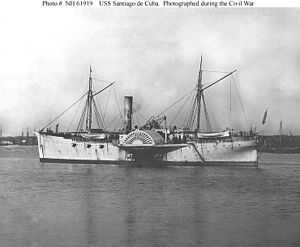USS Santiago de Cuba (1861)
 USS Santiago de Cuba (1861) | |
| Career (US) | |
|---|---|
| Laid down: | date unknown |
| Launched: | 1861 at Brooklyn, New York |
| Acquired: | 6 September 1861 at New York City |
| Commissioned: | 5 November 1861 at the New York Navy Yard |
| Decommissioned: | 17 June 1865 at the Philadelphia Navy Yard |
| Struck: | 1865 (est.) |
| Fate: | sold, 21 September 1865 |
| General characteristics | |
| Displacement: | 1,567 tons |
| Length: | 229 ft (70 m) |
| Beam: | 38 ft (12 m) |
| Draught: | depth of hold 27' draft 16' 2" (max.) |
| Propulsion: | sail and steam engine side wheel-propelled |
| Speed: | 14 knots |
| Complement: | 114 officers and enlisted |
| Armament: | two 20-pounder Parrott rifles eight 32-pounder guns |
| Armour: | wood |
USS Santiago de Cuba (1861) was a brig acquired by the Union Navy during the first year of the American Civil War. She was outfitted as a gunboat with powerful 20-pounder rifled guns and 32-pounder cannon and was assigned to the Union blockade of the Confederate States of America.
Commissioned in New York City in 1861
USS Santiago de Cuba was a wooden, brigantine-rigged, side-wheel steamship built in 1861 at Brooklyn, New York. She was purchased by the Navy on 6 September 1861 at New York City; and was commissioned at the New York Navy Yard on 5 November 1861, Commander Daniel B. Ridgely in command.
Civil War service
Gulf of Mexico operations
The new steamer was ordered to Havana, Cuba,
- “... to protect legitimate commerce and to suppress communications and traffic with or by the insurgents . . .”
She reached Havana on 17 November. On 3 December, she captured British blockade runner schooner, Victoria, at sea some 90 miles west of Point Isabel, Texas, and sent the prize to Galveston, Texas. Four days later, she chased and overtook British schooner, Eugenia Smith, but released her for want of evidence justifying a seizure. Thus, she began a career which kept her at sea during much of the Civil War.
Santiago de Cuba scored next on 26 April 1862 when she took schooner, Mersey, of Charleston, South Carolina; and she captured schooner, Maria, on the 30th off Port Royal, South Carolina. Schooner, Lucy C. Holmes, laden with cotton, fell into her clutches on 27 May, and the Union side wheeler seized blockade runners, Columbia on 3 August and Lavinia on the 27th—both off Abaco in the Bahamas.
Searching for commerce raiders and blockade runners
In September, Santiago de Cuba was assigned to a newly organized "Flying Squadron," created to seek out and capture Confederate commerce raiders Alabama and Florida. The squadron caught several prizes but never found the elusive Southern warships.
On 21 June 1863, Santiago de Cuba overtook Victory off Palmetto Point, Eleuthera Island, ending a long chase after the British steamer had slipped through the blockade off Charleston with a cargo of cotton, tobacco, and turpentine. On the 25th, she took steamer, Britannia, in the same area. On 15 July, she boarded steamer, Lizzie, east of the Florida coast and sent the prize to Key West, Florida for trial.
Late in the year, Santiago de Cuba sailed north for repairs and decommissioned on 30 December 1864.
North Atlantic blockade operations
Overhaul completed, the side wheeler recommissioned on 6 June 1864 and resumed her chase. Some three months later, Santiago de Cuba took A. D. Vance at sea northeast of Wilmington, North Carolina attempting to carry a cargo of cotton to Europe. On 2 November 1864, blockade runner steamer, Lucy, struck her colors in compliance with a demand from Santiago de Cuba.
Soon thereafter, the steamer began preparation for a new experience. She was assigned to the task force in which Rear Admiral David Dixon Porter attacked Fort Fisher on Christmas Eve, 1864. During the operation, she protected the landing troops as they went ashore, supported them during the fighting, and covered them as they reluctantly reembarked the next day, under orders of General Benjamin F. Butler, the army commander.
Porter immediately began work organizing a new invasion force. The union warships and Army transports returned to the vicinity of Wilmington in mid-January 1865. After a bloody three-day fight, Fort Fisher fell on the 15th.
The next day, Santiago de Cuba embarked men wounded in the battle and sailed for Norfolk, Virginia.
Medals of Honor
During the Civil War, the following crewmen of the USS Santiago de Cuba were awarded the Medal of Honor:
- Philip Bazaar, Ordinary Seaman, U.S. Navy
- John Griffiths, Captain of the Forecastle, U.S. Navy
- George Province, Ordinary Seaman, U.S. Navy
- Auzella Savage, Ordinary Seaman, U.S. Navy
- John Swanson, Seaman, U.S. Navy
- Edward Swatton, Seaman, U.S. Navy
- Augustus Williams, Seaman, U.S. Navy
Decommissioning and subsequent career
After the war ended, Santiago de Cuba was decommissioned on 17 June 1865 at the Philadelphia Navy Yard. She was sold at public auction in Philadelphia, Pennsylvania, on 21 September 1865.
She was redocumented on 16 November 1865. For more than two decades, she operated in mercantile service. On 7 December 1886, her engines were removed, and she was rigged as a schooner. Records of her subsequent career have disappeared.
See also
References
Pictures of the USS Santigo de Cuba
This article incorporates text from the public domain Dictionary of American Naval Fighting Ships. The entry can be found here.